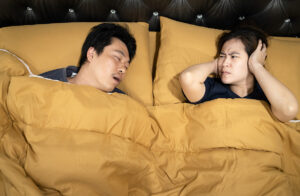Snoring is a common problem in people, and so the question is: can surgery help with snoring? About 25% of adults snore regularly, 45% snore occasionally. You are more likely to snore when you are overweight. Other factors are being a middle-aged or older male or a postmenopausal woman. Over the last decades various surgical procedures were in development in an attempt to cure snoring.
Obstructive sleep apnea
A person with obstructive sleep apnea has a problem of a relaxed rooftop in the mouth, where the uvula drops down. At the same time the tongue is falling backwards and together with the relaxed rooftop this leads to intermittent obstruction of the airway. The end result is loud snoring, which can lead to intermittent cessation of breathing. A positive pressure device is a common remedy for this condition, which keeps the airway open during your sleep. It is called continuous positive airway pressure (CPAP). However, this system is somewhat noisy, and about 50% of patients find it disturbing and cannot tolerate it. Many patients prefer a surgical, permanent solution.
Classification of snoring
Most snorers have primary snoring. Among these patients there is a minority who stop breathing periodically, which lowers the blood oxygen content. The patient awakes from this and tightens the muscles in the palatine-pharyngeal area and then breathes normally again for a while. These patients have obstructive sleep apnea (OSA). However, when deeper sleep is reached in OSA patients the cycle repeats itself. A clinical test how to distinguish between primary snoring and OAS is a polysomnography study, which also goes by the name of a sleep study.
Uvulopalatopharyngoplasty
This sounds like a tongue twister! In lay terms it is a surgical procedure which removes the uvula and the adjacent tissues of the palate and throat walls. There are side effects like swallowing problems, throat changes and the permanent feeling of a foreign body in the throat. Since the original design several modifications were introduced, which reduce the side effects of this procedure, but do not entirely eliminate them.
Somnoplasty or radiofrequency ablation
For patients with primary snoring, who do not have OSA a new procedure utilizes low levels of radiofrequency heat energy to create finely controlled localized burns in the lining of the soft tissues of the palate. This tightens the palate tissue and avoids the vibrations that cause snoring. The procedure can be done in the office setting under local anesthetic. It takes only about 30 minutes. When researchers compared pre-treatment scores with scores after three years following two ablation radiofrequency treatments there was a significant reduction of the snoring activity. Somnoplasty is another name for the FDA approved ablation radiofrequency treatment. This treatment works well for patients with primary snoring, but is not so successful for patients with OSA.
Maxillomandibular advancement (MMA)
The physician orders this fairly invasive surgery for patients with OSA who cannot tolerate continuous positive airway pressure. The goal of the surgery is to remove the two obstruction points where the patient chokes at night. This occurs most often behind the palate and behind the tongue. MMA was introduced more than 35 years ago. On the plus side, the success rate is about 90%. The minus side is the fact that it is major invasive surgery where the surgeon moves both the upper and lower jaws forward opening up the two choke points in the back. The surgery lasts about 6 hours and it takes approximately 6 weeks for it to heal.
Hypoglossal nerve stimulation
An alternative for patients with moderate to severe OSA is the use of hypoglossal nerve stimulation. Patients with OSA have a weakness in the muscle tone of the muscles that push the tongue forward. When they fall asleep the tongue tends to fall backwards obstructing the airways. This can be remedied with the use of hypoglossal nerve stimulation that stimulates the muscles that push the tongue forward.
Results with hypoglossal nerve stimulation devices were encouraging, as more than 80% of patients with OAS who had this device inserted had a successful treatment outcome. 4 years later, in the same patients there was still effectiveness of the hypoglossal nerve stimulator and the improvement in quality of life remained the same.
Conclusion
There are several procedures that can help patients with primary snoring or patients with an obstructive sleep apnea (OSA). For patients with primary snoring, who do not have OSA a new procedure utilizes low levels of radiofrequency heat energy to create finely controlled localized burns in the lining of the soft tissues of the palate. This tightens the palate tissue and avoids the vibrations that cause snoring. In patients with obstructive sleep apnea a continuous positive airway pressure device (CPAP) is a common remedy for this condition, which keeps the airway open during their sleep. But only about 50% of patients tolerate this procedure.
More surgical procedures
The uvulopalatopharyngoplasty can help a certain number of patients. Here the ear/nose/throat surgeon removes the uvula and the adjacent tissues of the palate and throat walls. The surgeon does this under general anaesthesia, and patients will take about two weeks to fully recover. Another more invasive procedure is the maxillomandibular advancement (MMA). The goal of the surgery is to remove the two obstruction points where the patient chokes at night. This occurs most often behind the palate and behind the tongue. The surgical procedure is in use for more than 35 years and the success rate is about 90%. However the surgery will take several hours, and recovery of the patient will take about 6 weeks.






